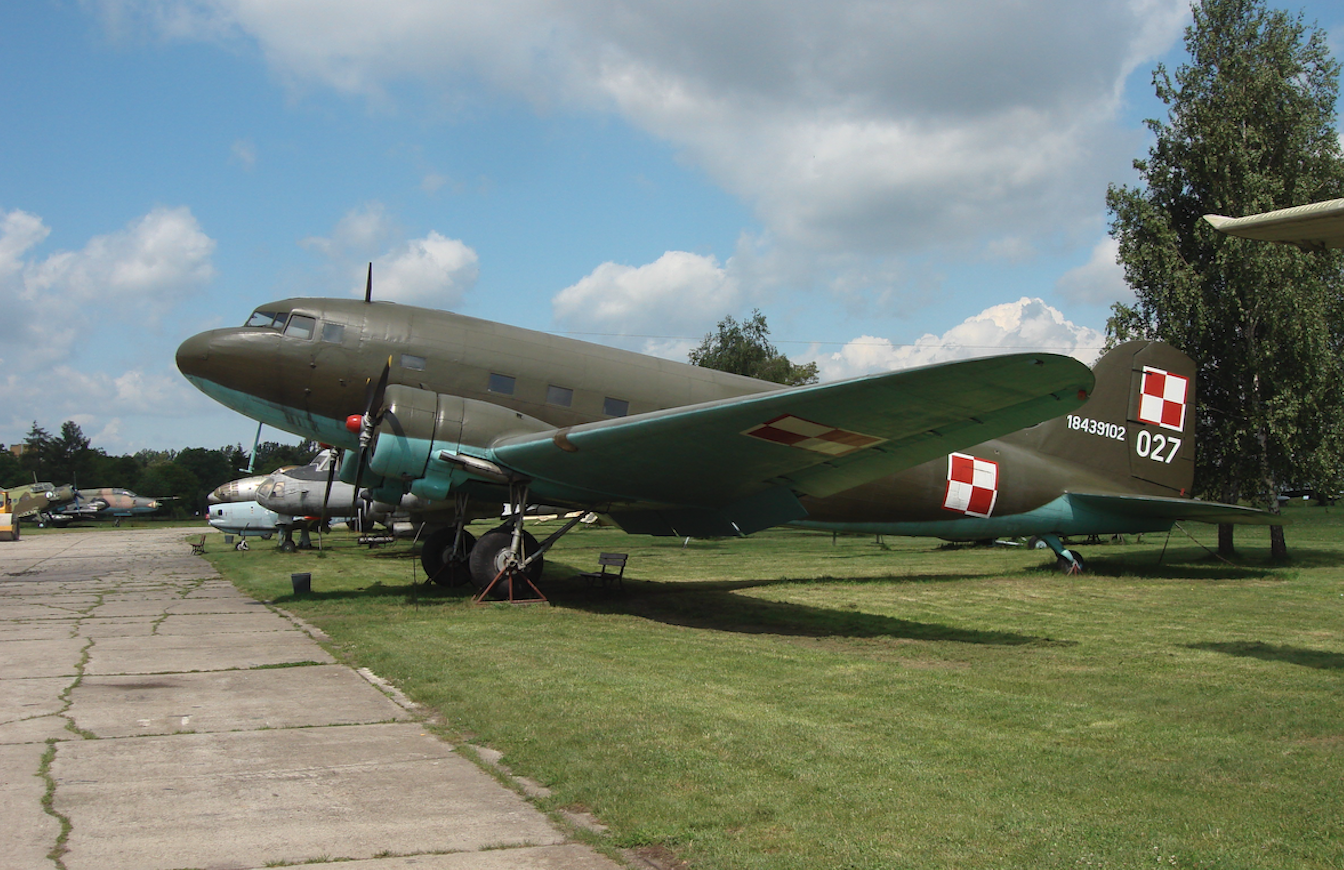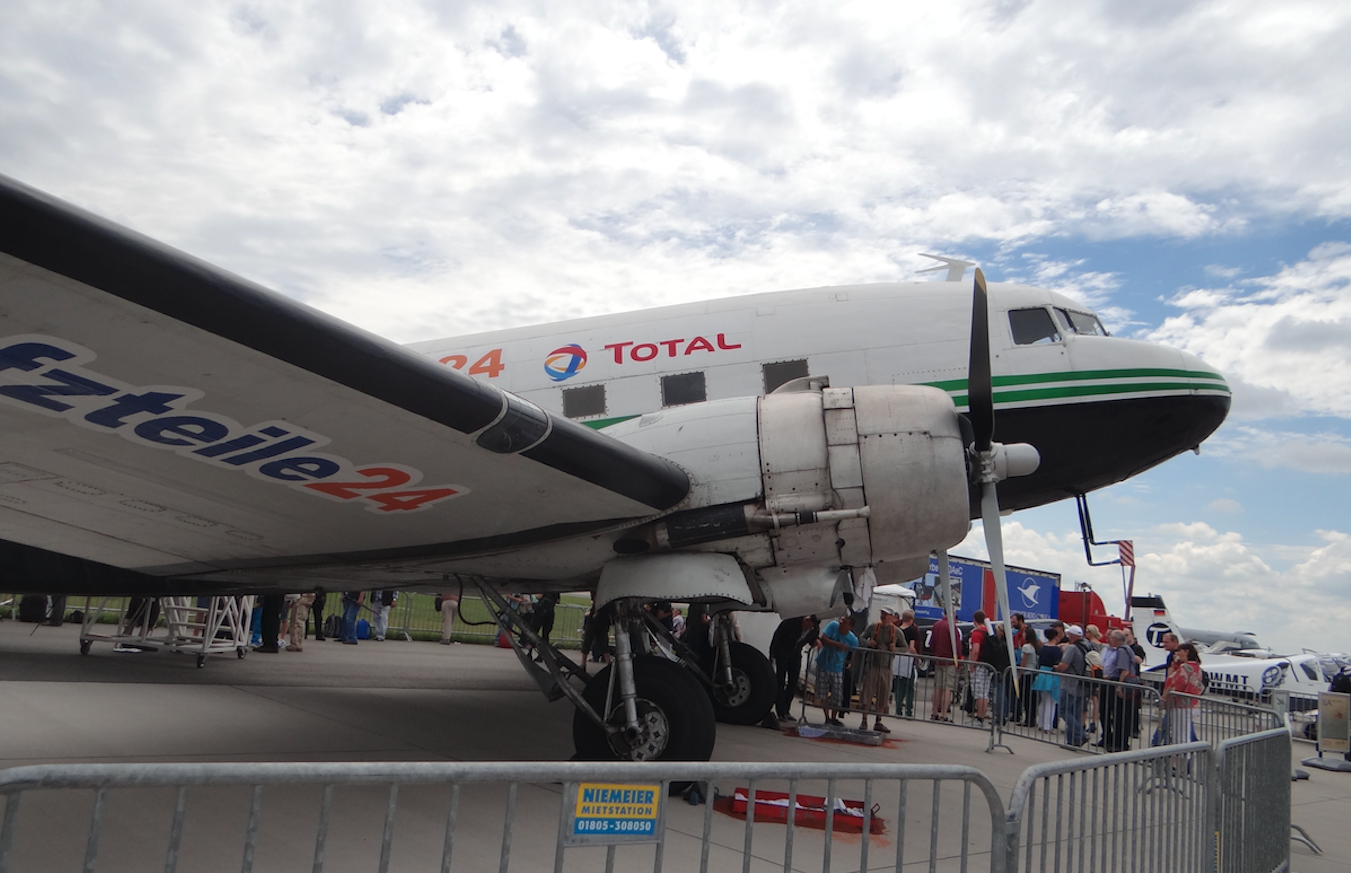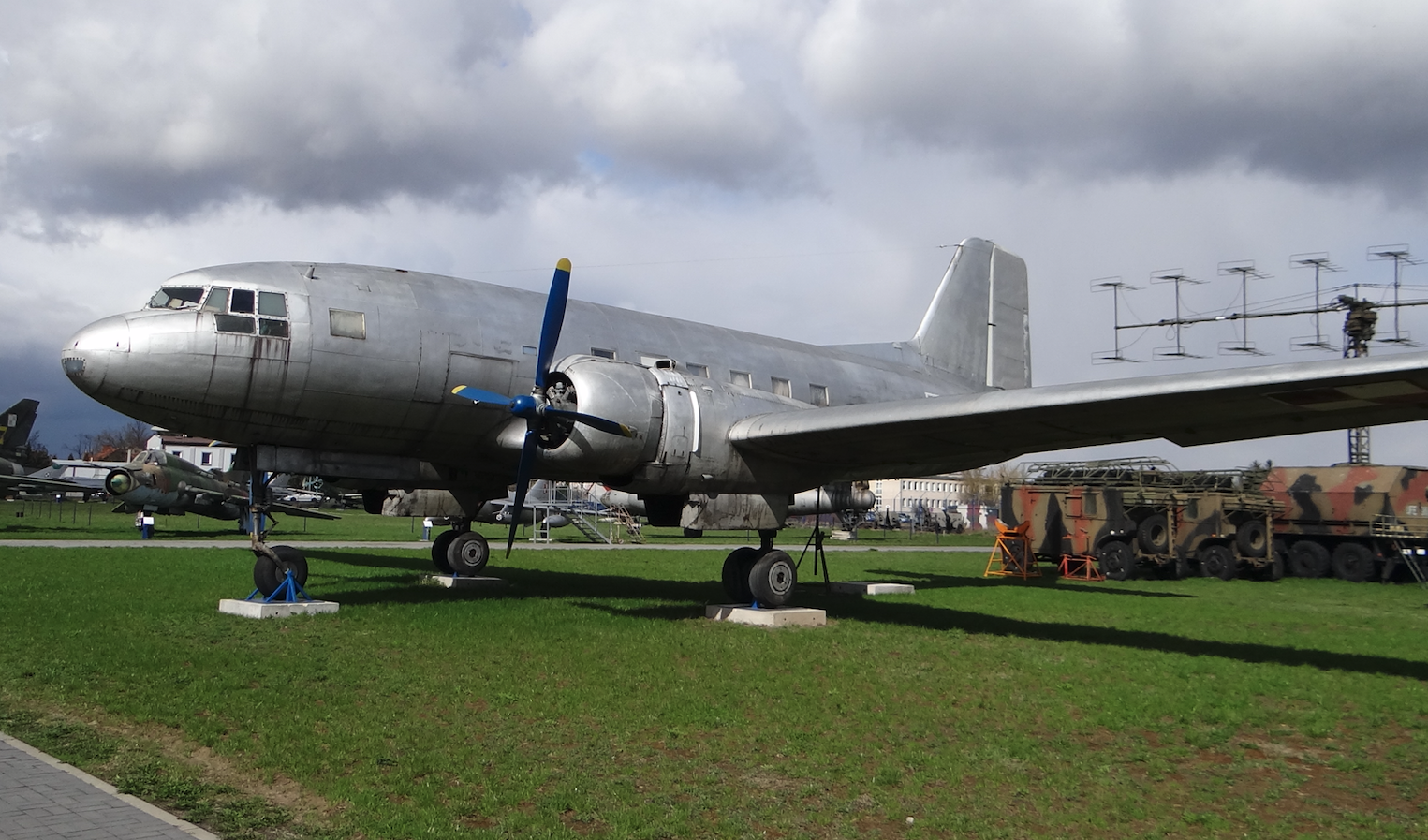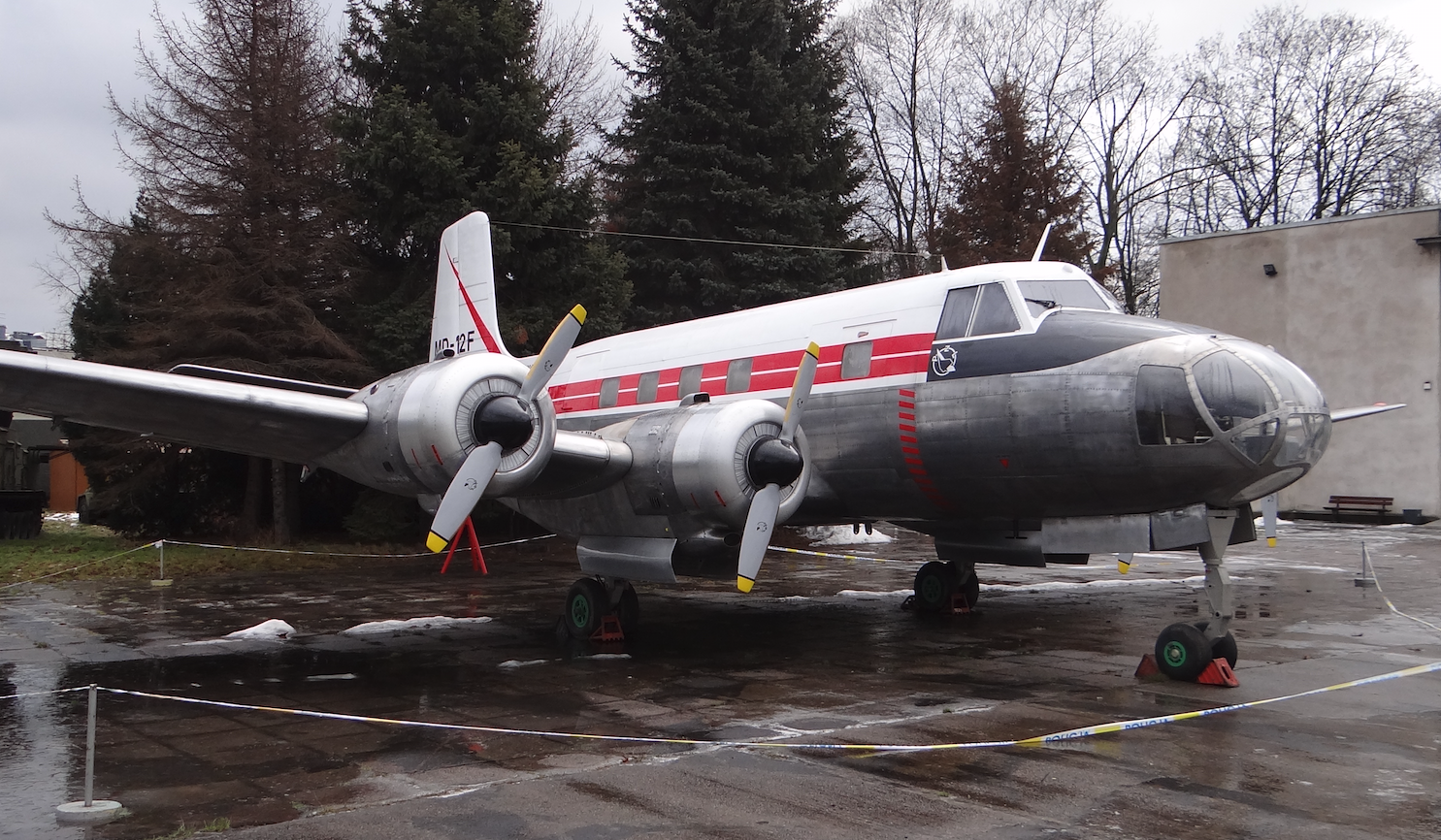Kraków 2014-04-15
Historia Polskich Linii Lotniczych LOT.
Część 2.
1945r.-1962r.
Po drugiej wojnie światowej.
W 1944 roku, rozpoczęła się nowa okupacja Polski. Tym razem moskiewska. Władze w Polsce sprawował Kreml, przy pomocy ustanowionego przez siebie komunistycznego rządu w Polsce. Dla zachowania pozorów demokracji wskrzeszano przedwojenne instytucje, ale z nowym, komunistycznym kierownictwem. W marcu 1945 roku, reaktywowano przedsiębiorstwo PLL LOT. Z przedwojennej firmy pozostał tylko Żuraw, czyli logo firmy. Nawet nie zachowano systemu kierowania państwowo-samorządowego. Zarząd firmy stał się wojskowo-komunistyczny.
Lecz początków powojennego PLL LOT należy szukać w Wydziale Lotnictwa Cywilnego, który zorganizowano w 1944 roku. W dniu 15.08.1944 roku, Wydział Lotnictwa Cywilnego uruchomił dwie linie lotnicze; Lublin (Lotnisko Dys) – Białystok oraz linię okrężną Lublin – Przemyśl – Rzeszów – Lublin. Lotnisko Dys leżało 10 km na północ od Lublina. Wkrótce uruchomiono także połączenie do Mińska Mazowieckiego, które po 17.01.1945 roku, zostało zastąpione Warszawą. Rozważano loty do Lwowa i Wilna, ale Moskwa ich zakazała, bo miasta te zostały wcielone do CCCP. Loty wykonywano na rzecz Polskiego Komitetu Wyzwolenia Narodowego (umocowanego na Kremlu), przy pomocy trzech samolotów Li-2, a później i małymi samolotami Po-2. Pasażerami byli funkcjonariusze nowej władzy. Wożono pocztę służbową i materiały propagandowe. Do końca 1944 roku, przewieziono prawie 5 000 osób i 70 000 kg przesyłek.
W dniu 6.03.1945 roku, przy Departamencie Lotnictwa Cywilnego reaktywowano PLL LOT. w dniu 16.03.1945 roku, zapadła decyzja, że zorganizowaniem PLL LOT zajmie się Dowództwo Wojsk Lotniczych. Dlatego w dniu 28.03.1945 roku, ukazał się Rozkaz Dowódcy Wojska Polskiego Nr 66/org. O stworzeniu czterech cywilnych jednostek lotniczych. W rozkazie tym była mowa między innymi o utworzeniu; 7. Samodzielnej Eskadry Transportowej Lotnictwa Cywilnego, która dysponowała 10 samolotami typu Li-2. Natomiast 18. i 19. Samodzielny Pułk Transportowy Lotnictwa Cywilnego dysponowały ponad 100 samolotami Po-2 i woziły pocztę i gazety. Ze wspomnianego powyżej Rozkazu powstała jeszcze jedna jednostka; 8. Samodzielna Eskadra Transportowa, która wykonywała loty na zlecenie Ministerstwa Bezpieczeństwa Publicznego. Przewoziła między innymi aresztowanych i skazanych członków reakcyjnego podziemia, czyli Żołnierzy Niezłomnych.
W dniu 30.03.1945 roku, 7. Samodzielna Eskadra Transportowa Lotnictwa Cywilnego, będąca w rzeczywistości firmą PLL LOT uruchomiła pierwszą linię okrężną; Warszawa-Łódź-Kraków-Rzeszów-Lublin-Warszawa. W ciągu pierwszych trzech miesięcy wykonano około 1 500 lotów i przewieziono około 20 000 osób. W marcu, kwietniu i maju 1945 roku, w kilku miastach powstały oddziały krajowe PLL LOT. Były to oddziały w Łodzi, Krakowie, Rzeszowie, Lublinie, Białymstoku, Katowicach, Wrocławiu, Poznaniu, Bydgoszczy, Koszalinie i Gdańsku.
Pierwszy powojenny plakat reklamowy PLL LOT, przedstawiał samoloty lecące nad ruinami obok klucza żurawi. Napis na plakacie głosi: „Skrzydła PLL LOT pomogą w odbudowie”.
W dniu 18.07.1945 roku, dekretem Rady Ministrów powstał Przedsiębiorstwo Państwowe Polskie Linie Lotnicze LOT, przekształcone z 7. SETLC. Naczelnym dyrektorem został Wojciech Zieliński, przedwojenny prokurent PLL LOT.
W lipcu i sierpniu 1945 roku, wszystkie samoloty otrzymały Polskie rejestracje. Przybyło także Polskich pilotów, bo do tej pory załogi były złożone z żołnierzy rosyjskich. Pierwszymi Polskimi pilotami byli; Medard Konieczny, Stanisław Kostecki, Mieczysław Sadowski, Zdzisław Stróżowski, Władysław Szumowski, Stanisław Żyźniewski. Potem wyszkolono kolejną Polską grupę lotników nawigatorów, radiooperatorów i mechaników pokładowych. W wrześniu 1945 roku, odbył się drugi kurs pilotów. Do końca 1945 roku, wyszkolono (przeszkolono) ponad 100 osób; 25 pilotów, 8 nawigatorów, 23 radiooperatorów i 25 mechaników pokładowych.
Ponieważ komuniści zwiększyli swoje zapotrzebowanie w temacie „utrwalania władzy ludowej” i zapotrzebowania na loty, dlatego ilość lotów na rzecz transportu komercyjnego drastycznie spadła. Od września do grudnia 1945 roku, nie wykonano nawet 150 lotów. Choć w ofercie była już trasa okrężna; Warszaw – Łódź – Katowice – Poznań – Łódź – Warszaw oraz loty do Bydgoszczy i Gdańska.
W dniu 6.12.1945 roku, ukazał się Rozkaz o rozformowaniu czterech jednostek transportowych lotnictwa cywilnego. Samoloty Li-2 otrzymały barwy PLL LOT, a samoloty Po-2 trafiły do Departamentu Lotnictwa Cywilnego.
1946 rok.
W 1946 roku, nastąpiło faktyczne przejęcie od Polskiego Wojska 10 samolotów typu Lisunow Li-2. Jednocześnie uruchomiono pierwsze regularne połączenie Warszawa (Lotnisko Okęcie) – Gdańsk (Lotnisko Wrzeszcz). W dniu 8.08.1946 roku, Rada Ministrów zatwierdziła statut PLL LOT i właściwie 1946 rok, należy uznać za reaktywowanie działalności PLL LOT.
Samoloty Lisunow Li-2 eksploatowano w PLL LOT do 1967 roku, a skreślono je ze stanu w 1969 roku. Na pewno samolot Li-2 był najliczniej eksploatowanym samolotem w PLL LOT. W 1955 roku, było ich 40 egzemplarzy.
Także 1946 roku, dla PLL LOT zakupiono 9 maszyn DC-3, które rozpoczęto eksploatować na liniach zagranicznych. Otrzymały one rejestracje: SP-LKA, SP-LKB, SP-LKC, SP-LKD, SP-LKE, SP-LKF, SP-LKG, SP-LKH, SP-LKI. Były to samoloty zakupione z demobilu, w wersji C-47 A. W kabinie pasażerskiej były jedynie metalowe ławeczki. Tych samolotów, w trakcie drugiej wojny światowej zbudowano bardzo dużo i po wojnie były one bardzo tanie. Kabinę zmodernizowano i zamontowano 21 foteli, w układzie 2+1 w 7 rzędach. W 1957 roku, dokonano kolejnej modyfikacji wnętrza montując 24 fotele. Samoloty te wykonywały rejsy za granicę do: Paryża, Sztokholmu, Pragi i Berlina. Ostatni DC-3 w PLL LOT zakończył służbę w 1959r roku i został sprzedany do Iranu.
1947 rok.
W dniu 21.03.1947 roku, został zademonstrowany w Warszawie czterosilnikowy samolot pasażerski SNCASE SE-161 Languedoc. W maju 1947 roku, PLL LOT kupił 5 samolotów tego typu. Przeznaczone były przede wszystkim do obsługi dłuższych linii zagranicznych. Kupione samoloty w wersji SE-161/1 Languedoc B-2 były wyprodukowane w okresie 1946 – 1947. Otrzymały one znaki rejestracyjne: SP-LDA, SP-LDB, SP-LDC, SP-LDD, SP-LDE. Pierwsze trzy maszyny przybyły do Polski w dniu 5.07.1947 roku i od 1.08.1947 roku, weszły na trasy. W październiku 1947 roku, przybył czwarty samolot, a piąty w 1948 roku.
Początkowo zamierzano zakupić łącznie 10 samolotów SE-161 dla zapewnienia szybkiego rozwoju linii zagranicznych. Niestety, bardzo awaryjne okazały się silniki. Doprowadziły one do kilku przymusowych lądowań. W dniu 31.05.1948 roku, podczas lotu samolotu SP-LDA z Warszawy do Paryża kolejno zatrzymały się 3 silniki i samolot lądował przymusowo ze złożonym podwoziem pod Reims. Na szczęście pasażerom nic się nie stało, a samolot nadawał się do remontu. Po tym wypadku zawieszono loty na wszystkich samolotach SE-161 w PLL LOT. Wytwórnia zaproponowała wymianę silników na Pratt Whitney R-1830. Silników jednak nie wymieniono, a wiosną 1950 roku, samoloty skasowano. Razem z wyremontowanym i nie odebranym z Francji SP-LDA. Languedoc był pierwszym samolotem 4-silnikowym użytym w Polskiej komunikacji lotniczej. Fatalna kondycja techniczna samolotów SNCASE SE-161 Languedoc, dała komunistom doskonały argument co do niskiej jakości zachodniej techniki. Z użytkowaniem Languedoc przez PLL LOT wiążą się również ludzkie tragedie. Władze PRL oskarżyły kilku kluczowych pracowników PLL LOT, związanych z eksploatacją tego samolotu, o działalność sabotażową i skazano ich na śmierci.
1949 rok.
W 1949 roku, Polskie Linie Lotnicze LOT kupiły 5 samolotów pasażerskich Ił-12 B, które otrzymały znaki rejestracyjne: SP-LHA, SP-LHB, SP-LHC, SP-LHD, SP-LHE. Nowy samolot po raz pierwszy publicznie zademonstrowano na Okęciu w dniu 4.09.1949 roku, z okazji Święta Lotnictwa. Samolot pokazano także w powietrzu demonstrując lot ze wznoszeniem na jednym pracującym silniku przy wyłączonym drugi, którego łopat ustawiono w chorągiewkę. Samoloty miały zamontowane 18 lub 21 foteli pasażerskich. Ich liczbę w trakcie eksploatacji zwiększono do 28 sztuk.
W 1952 roku, na kilka miesięcy wypożyczono jeszcze jeden samolot Ił-12 B, który otrzymał rejestrację SP-LHF. W PLL LOT samoloty użytkowano do końca 1957 roku, a ostatnie trzy maszyny, o rejestracjach SP-LHA, SP-LHB, SP-LHC pozostawiono w rezerwie zakonserwowane do listopada 1959 roku. Samoloty Iliuszyn Ił-12 pozwoliły na zwiększenie siatki połączeń. Rozpoczęto loty do Bukaresztu, Budapesztu, Brukseli i Kopenhagi.
1955 rok.
Firma PLL LOT kupiła w CCCP w 1955 roku, 4 samoloty Iliuszyn Ił-14 P, a w 1956 roku, kolejne dwa. W 1957 roku, sprowadzono z NRD 6 maszyn VEB Ił-14 P i z Czechosłowacji jeden pasażersko-transportowy AV-14, z dużymi drzwiami załadunkowymi. Samoloty z CCCP otrzymały oznaczenia SP-LNA, SP-LNB, SP-LNC, SP-LND, SP-LNE, SP-LAF. Samoloty z NRD oznaczono rejestracjami SP-LNG, SP-LNH, SP-LNJ, SP-LNK, SP-LNL, SP-LNM. Samolot z Czechosłowacji AV-14 otrzymał rejestrację SP-LNN. Ponadto w okresie 1963 – 1964, firma PLL LOT wypożyczyła 3 samoloty VEB Ił-14 P. Miały one różne numery fabryczne, ale otrzymały rejestrację SP-LNO, SP-LNP, SP-LNR. Łącznie PLL LOT eksploatował 16 maszyn Ił-14.
Podczas eksploatacji w PLL LOT samoloty poddawano licznym modernizacjom. Zwiększano liczbę miejsc pasażerskich z 18 do 26, a następnie 32. Zlikwidowano grzbietowe kopułki astro w Ił-14 P. Samoloty VEB Ił-14 P w ogóle ich nie miały. Wzmocniono skrzydło i dodano ósme okno w przedzie kabiny pasażerskiej oraz inne drobniejsze zmiany.
W 1955 roku, uruchomiono nowe połączenia lotnicze do; Wiednia i Moskwy. Może niektórych czytelników dziwi uruchomienie połączenia do Moskwy dopiero w 1955 roku. Ale trzeba wiedzieć, że stałe połączenie Warszawy z Moskwą było utrzymywane poprzez samoloty wojskowe operujące z Lotniska Bemowo.
Według dostępnych informacji, to w 1955 roku, PLL LOT zanotował pierwszy 1 000 000 przewiezionych pasażerów od początku swojej działalności.
Convair Liner CV-240 w PLL LOT. 1957 rok.
Ponieważ państwa Europy Zachodniej nie chciały przyjmować u siebie samolotów produkcji CCCP, Polski przewoźnik PLL LOT był zmuszony dokonać zakupu samolotów zza żelaznej kurtyny. Był to okres PRL po Powstaniu Poznańskim i pojawiały się nieliczne symptomy odwilży. W jesieni 1957 roku, kupiono pierwsze trzy samoloty Convair Liner CV-240-12 od linii lotniczej Sabena. Samoloty posiadły silniki Pratt-Whitney R-2800-CB16. Otrzymały one rejestracje; SP-LPA, SP-LPB, SP-LPC. Firma Sabena (Societe Anonyme Belge d’Exploitation de la Navigation Aerienne) była państwowymi liniami lotniczymi w Belgii. Założona w 1923 roku, a upadła w 2001 roku. Siedziba Bruksela. Samoloty wylądowały na Lotnisku Okęcie w dniu 15 października 1957 roku. Już od dnia 1.04.1958 roku, samoloty weszły do siatki połączeń PLL LOT. Samoloty wykorzystywano na liniach Warszawa-Wiedeń, Warszawa-Paryż, Warszawa-Londyn, Warszawa-Zurych. Te dwa ostatnie połączenia były nowymi w siatce i uruchomiono je w 1958 roku. Samoloty Convair CV-240 były pierwszymi maszynami w PLL LOT z hermetyczną kabiną i jednocześnie największymi we flocie.
W czasie przeszkalania załóg w dniu 12.04.1958 roku, na Lotnisku Okęcie doszło do wypadku samolotu Convair CV-240 rejestracja SP-LPB. Podczas startu, na wznoszeniu, samolot przepadł i uderzył o ziemię. Został poważnie uszkodzony i podjęto decyzję o jego skasowaniu. Oficjalny komunikat mówił o błędzie pilotażowym załogi. Łatwo zrzucić winę na załogę. Jakie to typowe i proste.
Ponieważ samoloty spisywały się bardzo dobrze i były ekonomiczne, z początkiem 1959 roku, podjęto decyzję o kupieniu kolejnych dwóch używanych maszyn. Na rynku wtórnym znaleziono; (linia KLM) Convair CV-240-2, który otrzymał rejestracje SP-LPD oraz (linia Iran Air) Convair CV-240-4, który otrzymał rejestrację SP-LPE. Oba samoloty miały silniki Pratt & Whitney R-2800-CA18. Cztery samoloty (SP-LPA, SP-LPC, SP-LPD i SP-LPE) intensywnie eksploatowano do 1964 roku. W 1965 roku, pojawiły się trudności. Oficjalnie mówiono o problemach z pozyskaniem części zamiennych. W rzeczywistości, komuniści chcieli pozbyć się imperialistycznych samolotów. W 1965 roku, Polska odebrała ostatni nowy samolot Ił-18, produkcji CCCP. Łącznie w Polsce było już 10 maszyn typu Ił-18, używanych w Wojsku Polskim i PLL LOT. Ostatecznie samolot Ił-18 użytkowane w Polsce zabierały na pokład 105 pasażerów. Te samoloty całkowicie pokrywały zapotrzebowanie na obsługę siatki połączeń PLL LOT. Dlatego w 1966 roku, cztery samoloty Convair CV-240 i ostatni Vickers Viscount (rejestracja SP-LVC) zostały wystawione na sprzedaż. Samoloty Convair CV-240 powróciły do USA.
1961 rok.
W dniu 24.08.1961 roku, PLL LOT i WSK-Okęcie zawarły umowę przewidującą wynajęcie przez PLL LOT samolotu MD-12 dla przewozu pasażerów na linii Warszawa-Rzeszów-Warszawa w okresie od 28.08.1961 roku do 30.09.1961 roku. Maszyna MD-12 jest Polskim samolotem pasażerskim opracowany w PZL-Okęcie. Celem umowy było; dokonanie oceny przydatności MD-12 w LOT. Ocenienie prędkości przelotowe z pasażerami i zużycie paliwa. Zebrane doświadczeń dla przyszłej eksploatacji w LOT.
Wykonano 120 lotów i przewieziono łącznie 1 730 osób w łącznym czasie przelotów wynoszącym 129 godzin. Loty wykonywano dwa razy dziennie tam i z powrotem. Nie trudno z tego wyliczyć że; Jeden przelot trwał około 1 godziny. Średnia prędkość wynosiła 280 km/h. Całkowity koszt materiałów pędnych na 1 godzinę lotu wyniósł 55,4 % kosztu dla Li-2. Całkowity koszt paliwa na 1 godzinę i 1 pasażera wyniósł 58,5 % kosztu dla Li-2. Całkowity koszt paliwa na pasażerokilometr wyniósł 57,0 % kosztu dla Li-2. Z uwagi na max zasięg samolotu wynoszący 650 km samolot można było spokojnie tankować tylko na Okęciu. Dzięki temu potwierdzona została w praktyce zdolność samolotu MD-12 do ekonomicznej eksploatacji. Samolot spełnia postawione przed nim zadania. W okresie 1962 – 1963, kontynuowano szereg lotów reklamowych, wycieczkowych i dyspozycyjnych. Nie wpłynęło to jednak na zainteresowanie samolotem przez PLL LOT. Nie wpłynęło, bo nie mogło, w takiej konfiguracji władzy. Po prostu układ gwiazd dla MD-12 był niekorzystny, od samego początku. W wytwórni prace prowadzono nadal, głównie nad poprawieniem ogrzewania i odladzania. Nad obniżeniem hałasu. Nad poprawieniem zasięgu urządzeń radiowych.
Iliuszyn Ił-18 w PLL LOT.
Od 1959 roku, w ofercie Moskwy pojawił pierwszy turbośmigłowy samolot pasażerski Ił-18, którego protoplastą jest bombowiec B-29. W marcu 1961 roku, do Polski dostarczono pierwsze trzy egzemplarze samolotu Ił-18 W. Otrzymały one znaki rejestracyjne SP-LSA nr 180002403, SP-LSB nr 180002404, SP-LSC nr 181002805. Były to samoloty nowe. Dwa pierwsze z 1960 roku, trzeci z 1961 roku.
W kwietniu 1964 roku, przyleciał kolejny Ił-18 W nr 184007102, który zarejestrowano jako SP-LSD. Był to także nowy samolot zbudowany w 1964 roku. Pod koniec 1965 roku. PLL LOT nabył kolejne maszyny; Ił-18 W SP-LSE nr 181002504, używany, a zbudowany w 1961 roku. Kolejne to dwa Ił-18 E nowe, rok produkcji 1965 roku. SP-LSF nr 185008601 i SP-LSG nr 185008603. W lipcu 1966 roku, przybył do Warszawy ósmy Ił-18 W SP-LSH nr 181002701. Samolot był używany i przeszedł już pierwszy remont. Zbudowany był w 1961 roku. Dziewiąty Ił-18 w wersji E firma PLL LOT przejęła od wojska w marcu 1975 roku. SP-LSI nr 185008905 zbudowany był w 1965 roku.
Samoloty w PLL LOT rozpoczęły obsługę połączeń zagranicznych. Pierwszy lot wykonał Ił-18 SP-LSA w dniu 24.05.1961 roku, do Moskwy. Większość samolotów była wykonana z kabiną dostosowaną do jednej klasy, lux, ze 87 miejscami. W trakcie remontów zostały one przerobione w całości na klasę ekonomiczną z 99 miejscami. Remonty wykonywano w zakładach w Moskwie na lotnisku Bykowo. Podczas remontów modernizowano wyposażenie awioniczne pod kątem nowych wymagań. Na kadłubach pojawiała się nowe anteny. Zmieniano także tablice przyrządów w kabinie pilotów. Ostatnie modyfikacje Polskich Ił-18 doprowadziły do ich zunifikowania do 105 miejsc pasażerskich. Znikły całkowicie różnice pomiędzy poszczególnymi egzemplarzami. W czerwcu 1975 roku, dwa samoloty Ił-18; SP-LSA i SP-LSC przerobiono na towarowe. Usunięto z nich fotele. Zamontowano większe boczne drzwi ładunkowe. Samoloty Ił-18 w PLL LOT wylatywały rocznie średnio 1 600 – 1 800 godzin. Na Polskich Ił-18 nie wydarzyła się żadna katastrofa. Na przełomie 80/90-latach samoloty Ił-18 wycofano z PLL LOT. Kilka maszyn zostało przejętych przez firmę Polonia Airways i samoloty te latały jeszcze w 1997 roku. W 2004 roku, jeszcze pięć byłych Polskich Ił-18 (SP-LSF, SP-LSG, SP-LSI, SP-LSK, SP-FNW) znajdowały się w eksploatacji. Samolot miał kilka zalet. Jak na ówczesne czasy miał dużą pojemność, duży zasięg, sporą niezawodność, duży udźwig, przestronną kabinę pasażerską, stosunkowo szerokie wygodne fotele, szerokie przejście między fotelami. Do wad zaliczyć można; duży poziom hałasu w kabinie, spore wibracje charakterystyczne dla stosowanych silników.
Vickers Viscount dla PLL LOT. 1962 rok.
Nieznane są wszystkie przyczyny, dla których komuniści zdecydowali się na zakup samolotów Vickers Viscount (1962 rok) i to w okresie kiedy w PRL panowała już jedynie słuszna technika z CCCP. Należy sądzić, iż powodem były problemy z przyjmowaniem rosyjskich samolotów na Zachodnich lotniskach. Rosyjski samoloty nie spełniały norm obowiązujących na Zachodzie. Polski przewoźnik PLL LOT w tym czasie dysponował maszynami: Ił-2/DC-3, Ił-12, Ił-14. Do eksploatacji wprowadzano Ił-18. Program WSK Okęcie OKL MD-12 skasowano. W okresie 1957 – 1966. PLL LOT dysponował również czterema samolotami Convair CV-240. Były to maszyny nabyte z drugiej ręki. To te maszyny obsługiwały trasy na Zachodzie Europy, głównie do Londynu. W 1961 roku, PLL LOT wzbogacił się o trzy nowe turbośmigłowe Ił-18, ale nie uzyskały one zgody na lądowanie w portach Zachodniej Europy (przynajmniej początkowo), a Zachodni podróżni nie chcieli wsiadać na ich pokład.
W marcu 1962 roku, PLL LOT podpisał porozumienia na uruchomienie nowych połączeń rejsowych do Rzymu, Amsterdamu oraz Kairu. Chodziła plotka, że wstyd było wysyłać na nowe trasy Convair CV-240 (?), dlatego potrzebny był nowy samolot. Początkowo planowano zakup nowych maszyn (wszak Vickers Viscount był jeszcze produkowany). Komuniści zdecydowali się jednak na zakup trzech maszyn Vickers Viscount Typ 804, od brytyjskiej linii BUA (British United Airlines). Samoloty miały około 5 lat. Latały na wewnętrznych liniach wysp brytyjskich. Miały 56 miejsc pasażerskich. Ich prędkość przelotowa była dwukrotnie większa od samolotów Ił-12/Ił-14. Chodziła plotka, że transakcja była wyjątkową okazją. Lecz, okazją było to, że firma BUA uzyskała zgodę na sprzedaż tych maszyn do komunistycznego kraju. Faktem jest, iż w cenie samolotów była wymiana tapicerki foteli pasażerskich na nową i to w barwach LOT.
Co ważne, samoloty posiadały stacje radiolokacyjne. Lecz komuniści nie chcieli zapłacić za to wyposażenie, uznając je za zbytek, więc maszyny dostarczono pozbawione tego wyposażenia. Jak się okazało, było to brzemienne w skutkach. Istnieje jednak druga ewentualność; że firma BUA nie uzyskała zgody na sprzedaż maszyn ze stacjami radiolokacyjnymi, gdyż te mogłyby zostać użyte w celach militarnych. W trzeciej ewentualności jest powiedziane; że stacje radiolokacyjne były już przestarzałe i na samolotach należało zamontować nowe, takie które były montowane w nowo produkowanych egzemplarzach. Stacje te były produkowane przez USA i należałoby uzyskać zgodę od administracji USA, a podobno byłoby to długotrwałe, kosztowne i dodatkowo wymagałoby dodatkowego szkolenia załóg. Istnieje także informacja, że były pieniądze przeznaczone na zakup stacji radiolokacyjnych, ale zostały przeznaczone na zakup sprężarek rozruchowych na wyposażenie kilku lotnisk w Polsce. Jak było naprawdę, tego pewnie już się nigdy nie dowiemy.
We wrześniu 1962 roku, grupa 15 Polskich lotników wyjechała do UK. Prawie wszyscy mieli pokonane w powietrzu ponad 1 000 000 km. Byli i tacy którzy pierwszy milion kilometrów zdobyli jeszcze przed atakiem armii germańskiej na Rzeczypospolitą Polskę. Cała grupa celująco zaliczyła teorię. Loty okazały się nowością, bo Anglicy standardowo korzystali już z systemu ILS. W 1960 roku, system ILS zakupiono dla Lotniska Okęcie, ale go do końca 1962 roku, nie zamontowano. (Podobno nie było kabla, który trzeba było kupić na Zachodzie za dewizy!). Anglicy nie mogli wyjść z podziwu, jak Polscy piloci płynnie lądują, stosując system NDB, który tam był archaizmem. A w Polsce był używany jeszcze przez kolejne 50 lat(!). Po ośmiu tygodniach (listopad 1962 rok) kierownictwo PLL LOT arbitralnie stwierdziło, że „Polskie załogi są dobrze wyszkolone i mogą wracać do kraju”. Jednak Anglicy stwierdzili, że szkolenie nie zostało ukończone i nie wydali licencji. Nie mogli jednak zatrzymać przekazania samolotów. Anglicy proponowali jeszcze, że oddelegują instruktorów do Polski. Również na takie rozwiązanie kierownictwo PLL LOT się nie zgodziło. Cała sprawa miała drugie dno. Kierownictwo PLL LOT obawiało się, że pilotom tak spodoba się na Zachodzie, iż nie zechcą wrócić do kraju. Aby poprawić komfort psychiczny lotnikom, kierownictwo LOT zdecydowało, że załogi będą chwilowo trzy osobowe, choć samolot standardowo pilotowała załoga dwuosobowa.
Samolotom przypisano znaki rejestracyjne; SP-LVA, SP-LVB i SP-LVC. Pierwszy samolot wylądował w Warszawie 6.11.1962 roku i otrzymał rejestrację SP-LVA. Drugi lądował w dniu 27.11.1962 roku (SP-LVB). Trzeci dostarczono 22.12.1962 roku (SP-LVC). Kiedy w dniu 6.11.1962 roku (wtorek) Vickers Viscount SP-LVA wylądował na Lotnisku Okęcie i był witany przez władze partyjne i mieszkańców stolicy. W gazetach ukazały się obszerne artykuły na ten temat. O samolotach rozpisywano się bardzo pochlebnie. Następnego dnia (7.11.1962 rok) odbył się lot propagandowy.
Zanim dostarczono ostatni samolot, maszyna Vickers Viscount Typ 804 SP-LVB poleciała w rejs do Brukseli. Powrót odbywał się w dniu 19.12.1962 roku. Rejs Bruksela-Warszawa, z międzylądowaniem w Berlinie. Na pokładzie było 28 pasażerów i 5 członków załogi. Razem 33 osoby. Załoga kpt – Mieczysław Rzepecki, wówczas jeden z najmłodszych pilotów w PLL LOT, ale miał już przeleciane w powietrzu 2 500 000 km, drugi pilot – Henryk Kafarski, instruktor-kontroler – Józef Marczyk oraz dwie stewardesy – Maria Kowalik oraz Halina Breitkoph-Kieszkowska. Cały lot przebiegał bezproblemowo. O godzinie 17;55, planowo, samolot wystartował z Berlina. Jednak nad Warszawą warunki pogodowe były bardzo złe. Widzialność pozioma wynosiła około 1 000 m (według innych danych 7 000 m), podstawa chmur tylko 80 metrów (według innych danych 250 m). Samolot podchodził do lądowania na RWY 33. Załoga korzystała z sygnałów dwóch (według innych danych trzech) radiolatarni NDB i radiokompasu ADF. Około 19;20 załoga otrzymała zezwolenie na lądowanie. Pierwsze podejście było nieudane (samolot leciał za wysoko) i załoga skierowała maszynę na drugi krąg. Nie jest pewne, czy załoga przy pierwszej próbie, widziała światła RWY. Samolot po 4 zakręcie, będąc już na prostej, niespodziewanie utracił wysokość. Spadł z wysokości 60-70 m. Z impetem uderzył w ziemię, odbijając się następnie od zamarzniętej ziemi. Skręcił ostro w lewo. Od kadłuba odpadły skrzydła i fragment ogona. Sunąc już po ziemi z dużą prędkością stanął w płomieniach. Po zatrzymaniu eksplodowały zbiorniki paliwa. Po chwili, na miejsce zdarzenia przybyła Straż Pożarna oraz Pogotowie Ratunkowe. Nikt nie przeżył katastrofy. Cześć Ich Pamięci! Była godzina 19;31. Do progu RWY 33 było 1 335 m. Samolot w PLL LOT wylatał zaledwie 84 godziny. Wśród ofiar znajdował się między innymi Polski inżynier Fryderyk Bluemke, konstruktor silników dwusuwowych, m.in. silnika S-31 do samochodu Syrena oraz Marcin Szeligiewicz, Polski pedagog i działacz kulturalny, kompozytor, pianista.
Prowadząca śledztwo Główna Komisja Badania Wypadków Lotniczych Ministerstwa Komunikacji stwierdziła, iż w chwili katastrofy samolot był już skonfigurowany do lądowania: z wychylonymi klapami na skrzydłach i wysuniętym podwoziem. Stwierdzono także, iż nie doszło do żadnej eksplozji w powietrzu, a wszystkie uszkodzenia powstały w chwili kolizji z ziemią. Samolot lądował w trudnych warunkach atmosferycznych; zimą, po zmroku, podczas przyziemnego zamglenia, z zachmurzeniem 6/8, przy pułapie chmur fractostratus 250 m, widzialności na 7 000 m i temperaturze -5 stopni. Jednak inne źródła mówiły o jeszcze trudniejszych warunkach pogodowych. (widzialność 1 000 m, podstawa chmur 80 m i zamglenie). Jeśli tak, to kontroler powinien odesłać samolot na inne lotnisko (Modlin lub Łęczyca). Istnieje także domniemanie, iż jedna z radiolatarni NDB uległa awarii. Nie jest znana dokładna przyczyna katastrofy. Wśród możliwych przyczyn podaje się przeciągniecie. Konstrukcja turbośmigłowych silników Rolls-Royce miała zabezpieczenie przed gwałtownymi zmianami prędkości obrotowej. Przy stosunkowo niewielkiej prędkości obrotowej, gdy pilot dodawał gwałtownie gazu, łopaty śmigieł na kilka sekund zmniejszały kąt natarcia, aby ułatwić rozpędzenie się śmigła. Po czym ustawiały się na większą siłę pracy i dopiero wówczas samolot się rozpędzał. Instrukcja samolotu wyraźnie zabraniała gwałtownych zmian przepustnicy gazu, co w samolotach tłokowych było normalną praktyką. Faktem jest, iż całą winę za katastrofę zrzucono na kapitana, który nie mógł się bronić. W oficjalnym raporcie nie wspomniano o; niedokończonym szkoleniu w Anglii, zepsutych radiolatarniach NDB, nie zamontowanym systemie ILS. Jakie to charakterystyczne dla komuchów i masonów. Pokłosiem tragedii było sprowadzenie angielskiego instruktora i zamontowanie systemu ILS.
W dniu 20.08.1965 roku, samolot Vickers Viscount rejestracja SP-LVA, wystartował z Lotniska Okęcie. Na jego pokładzie znajdowała się tylko załoga. Samolot wylądował na Lotnisku Ławica w Poznaniu. Stamtąd zabrał pasażerów (głównie dzieci i młodzież) i poleciał do Lille we Francji. Następnie do Brukseli w Belgii. Na samym końcu, Viscount miał powrócić do Wrocławia, już bez żadnych pasażerów. Załogę SP-LVA, stanowili: kpt – Leszek Kmin, drugi pilot – Marian Kowalewicz oraz dwie stewardesy – Emilia Martowska oraz Jadwiga Kowalczuk. W tym dniu, przez całą Europę przechodziły fronty burzowe. Problemy zaczęły się w drodze powrotnej na trasie z Belgii do Polski. Kontrolerzy obszarowi Belgii widzieli samolot na ekranach stacji radiolokacyjnych, ale nie było z załogą łączności. Zaobserwowano liczne gwałtowne manewry samolotu. Być może załoga próbowała uniknąć lokalnych burz. Wrak maszyny odnaleziono w okolicach Jeuk St. Troud we Francji. Viscount rozbił się, uderzając uprzednio o słupy wysokiego napięcia. Cała załoga zginęła. Cześć Ich Pamięci! Przyczyna tej katastrofy, nie została wyjaśniona. Istnieją różne wersje wydarzeń, brakuje niestety dowodów. Prawdopodobnie w samolot uderzył piorun, który mógł spowodować uszkodzenie instalacji elektrycznej i problemy z orientacją.
PLL LOT zdecydował się pozbyć ostatniego Viscount, który ostatni lot rejsowy wykonał w 1966 roku. W 1969 roku, PLL LOT wystawił SP-LVC na sprzedaż. Zakupiła go Nowa Zelandia.
Katastrofy te nie mogą jednak wpłynąć na dobrą opinię o samolocie. W ponad 50 letniej eksploatacji maszyn odnotowano zaledwie 150 zdarzeń, wypadków i katastrof (w tym 59 z ofiarami śmiertelnymi), w okresie od 1952r. do 2003r. Na 444 egzemplarze przekazane liniom lotniczym, w 1988r. w regularnej eksploatacji znajdowało się około 31 maszyn, a w 2000r. jeszcze 5 maszyn.
W marcu 1962 roku, PLL LOT uruchomiła pierwsze pozaeuropejskie połączenia lotnicze. Pierwszą trasą była linia Warszawa – Kair, Egipt (2 607 km, 1 620 mil, 1 407 NM).
Opracował Karol Placha Hetman





